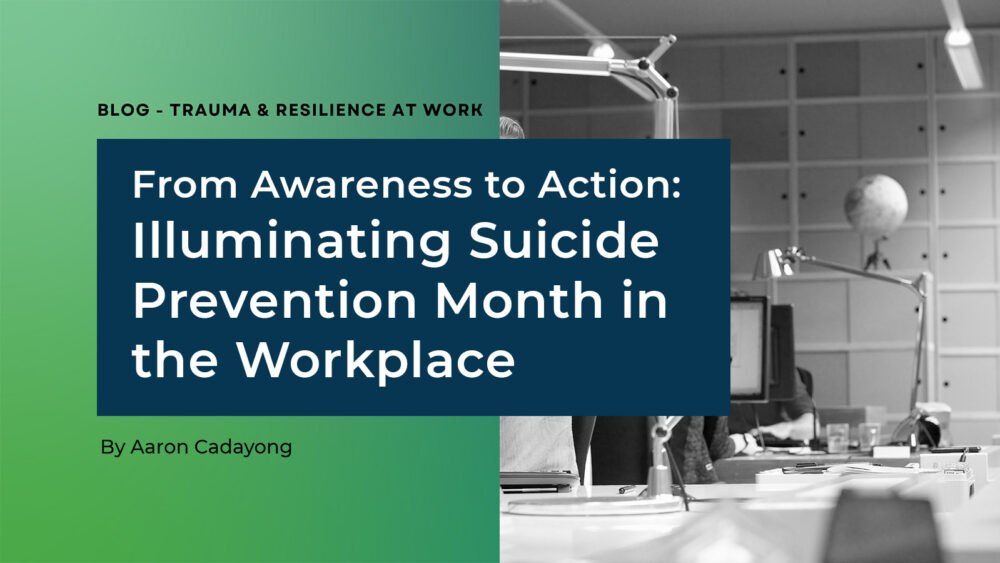September is Suicide Prevention Month, a time when we come together to raise awareness about suicide and take action to prevent it. Suicide is a serious public health problem that affects people of all ages, races, and backgrounds. Approximately 80% of suicides are by working aged people (ages 18-65; workplacesuicideprevention.com). This means we need to take extra care about suicide prevention plans in the workplace. As members of the workforce development sector, we can play a critical role in preventing suicide by creating a supportive and caring workplace environment.
We know it can be difficult to check in with someone we may be worried about. We may feel uncomfortable asking others about something as personal as their mental health. We may worry that they’ll take offense, or we’ll aggravate their vulnerability. We may think, “I should just mind my own business.” But we must remember that someone else’s safety is more of a priority than our comfort zone. When we think, “I should check up on my co-worker, I wonder if they are doing okay.,” we should do it and not allow our justifications to stay in our comfort zone outweigh our friends’, family members’, and colleagues’ safety.
The mental health of employees is a critical component of overall well-being and is essential to the success of any organization. A culture of care needs to be created within each workplace to ensure each person can thrive. Addressing mental health issues, including suicide prevention, is therefore a top priority for employers and business leaders. The beautiful thing about change is that it can start with one person being proactive to create a difference in their environment, and that person can be you! Please note that all this information is to help non-clinicians to improve their workplace environment, not to diagnose.
Factors Contributing to Mental Health Struggles
Several factors in the workforce development sector can contribute to mental health challenges, such as grant-funded jobs, demanding deadlines and workforce performance measures, adapting to technological changes, and stigma surrounding mental health. Additionally, many individuals have past or current traumatic experiences in their personal lives that may affect their work. This is why creating a trauma-informed and resilience-building workplace can make a difference in someone’s life. Although this can seem like a daunting task at first to recognize how trauma shows up in workforce development, part two of the Trauma and Resilience at Work Guide helps to better recognize trauma in the workplace.
The work environment can greatly affect the mental health of the workers, and there is still a lot of work to be done to improve. According to the 2023 Work in America Survey, more than 1 in 5 workers (22%) said they have experienced harm to their mental health at work (https:/www.apa.org/pubs/reports/work-in-america/2023-workplace-health-well-being). Without intervention or change, some of these cases of harm to mental health or harm could lead to suicidal thoughts, so take this month to create change in your work environment.
Building a Supportive Work Culture
Workplace culture plays a vital role in promoting mental health and suicide prevention among our employees and colleagues. Employers can foster an environment of openness, empathy, and support by offering more supportive supervision, opportunities to engage in teamwork, promoting taking breaks as needed and 100% of vacation time, employee assistance programs, counseling services, and other mental health resources. By creating a safe and supportive work environment, employees will feel more valued and appreciated, leading to healthier mental health, as well as increased job satisfaction and productivity. SAMSHA (Substance Abuse and Mental Health Services) gives six guiding principles for creating a trauma-informed and resilience-building workplace through safety:
https://www.cdc.gov/orr/infographics/6_principles_trauma_info.htm
- Safety
- Trustworthiness & Transparency
- Peer Support
- Collaboration & Mutuality
- Empowerment Voice & Choice
- Cultural, Historical, & Gender Issues
These are great places to focus on throughout national suicide prevention month, and beyond! You can learn more about how to cultivate a culture of resiliency in your work organization in part four of the Trauma and Resilience at Work Guide.
Recognizing Warning Signs
It is essential to recognize signs of emotional distress and potential suicidal behavior in employees and coworkers. Employers can provide training and education on how to identify these signs and take appropriate action. Collaboration with mental health professionals can also provide accurate information on recognizing signs and how to support someone who might be struggling.
According to the National Institute of Mental Health, here are the signs to consider for those who may be having suicidal ideations.
If they are talking about:
- Wanting to die
- Great guilt or shame
- Being a burden to others
If they are feeling:
- Empty, hopeless, trapped, or having no reason to live
- Extremely sad, more anxious, agitated, or full of rage
- Unbearable emotional or physical pain
If their behaviors have changed, such as:
- Making a plan or researching ways to die
- Withdrawing from friends, saying goodbye, giving away important items, or making a will
- Taking dangerous risks such as driving extremely fast
- Displaying extreme mood swings
- Eating or sleeping more or less
- Using drugs or alcohol more often
Practical Suggestions for Suicide Prevention Month and Every Month
Here are some compassionate suggestions that you can infuse into each week of Suicide Prevention Month, like drops of kindness into a shimmering pool, fostering a tapestry of support within your workplace. Instead of just saying that you will think more about suicide prevention this month, here are some actions that you can take every week. Remember that it is not your job to diagnose, but it is all of our responsibilities to look out for each other! Feel free to adjust and add to the list according to your circumstances.
Week 1: Learn about the Prevalence of Suicide
- Learn the statistics of suicide in the world and in the United States to increase your awareness of the prevalence of this national crisis. One place to start is through the CDC’s Suicide Prevention webpage (https://www.cdc.gov/suicide/suicide-data-statistics.html)
- Dig deeper and find out the prevalence of suicide in your state or city. (https://www.cdc.gov/nchs/pressroom/sosmap/suicide-mortality/suicide.htm)
- Discover the demographics that have higher suicide rates. (https://www.kff.org/other/state-indicator/suicide-rate-by-race-and-ethnicity/)
- Write down specific warning signs that you want to be on the lookout for in the workplace.
- Learn the best questions to ask when someone is in crisis, then write them down so you remember them. It is much easier to talk with someone exhibiting suicidal ideation in the moment if you have previously thought of effective questions to ask. (https://jedfoundation.org/resource/how-to-ask-someone-if-theyre-thinking-about-suicide/)
Week 2: Attend Virtual or In-Person Events
- Check out the resources section of this newsletter for upcoming virtual events to learn more about suicide prevention!
- Join a local suicide prevention group and see how you can help. One place to start is through American Foundation for Suicide Prevention Local Chapters. (https://talkawaythedark.afsp.org/#nspw)
- Many communities have fundraisers, 5k run/walk events, and other local activities in which you can participate.
Week 3: Foster Social Connections
- Organize a team-building activity at work to promote social connections and reduce isolation. Take a look at what a group of work leaders did in Detroit to accomplish this!
(https://skilledwork.org/news/trauma-resilience-ambassadors-create-thriving-workplaces/) - Encourage employees and colleagues to check in with one another and offer support.
- Provide opportunities for social support at work, such as peer support groups or mentoring programs.
- Open up to co-workers about your honest mental state and invite them to do the same if they feel comfortable.
Week 4: Promote Mental Health Resources
- Share mental health resources with your colleagues, such as the National Suicide Prevention Lifeline (988).
- Encourage your organization to provide mental health training for managers and employees. One great option is to learn more about Mental Health First Aid to receive training on how to identify, understand, and respond to signs of mental health and substance use challenges among adults.
(https://www.mentalhealthfirstaid.org/wp-content/uploads/2022/07/22.06.17_Adult-MHFA-Flier.pdf)Additionally, the Corporation for a Skilled Workforce offers trainings specifically tailored for workforce development organizations on trauma and resilience. - Learn more about how emotional trauma and toxic stress can affect the brain. Sometimes trauma can lead an individual to have thoughts of suicide. The Corporation for a Skilled Workforce has a free guide that you can download to better understand trauma in the workplace!
By coming together and taking action, we can create a culture of caring and support in our workplaces and help prevent suicide. Remember, suicide prevention is everyone’s business and the only path to prevention is proactivity. Together, we can make a difference.



Comments are closed.